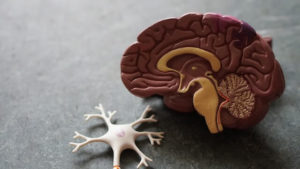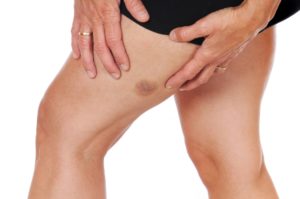
According to the CDC, 8 million people are treated in U.S. emergency departments for slip and fall injuries every year. [1]
Over 3 million of those falls are suffered by Americans 65 years or older. And the total medical cost of treating these falls was over $50 billion in 2015 alone. [2]
The most common injuries from slip and fall accidents include:
The severity of each of the injuries mentioned above will vary based on the circumstances of the fall and the surface on which the person lands.Below, we have discussed the common symptoms to look for after a fall. Please remember that we are not medical doctors, and all diagnoses should be given by a medical professional. You can learn more about what to do after a slip and fall accident here.It’s important to seek medical attention as soon as possible after a fall or any other accident that may have caused an injury and to speak with a Milwaukee slip and fall attorney.
1 – Sprains & Strains

- Pain
- Swelling or bruising
- Stiffness
- Muscle spasms
- Weakness or tenderness
- Cramping
If you are experiencing any of the symptoms above, you may have a sprain but it’s recommended that you see a doctor immediately after a slip and fall to receive a proper medical diagnosis.Doctors are better equipped to diagnose an injury and may discover other underlying injuries that are not immediately apparent.
For a free legal consultation, call 414-276-6666
2 – Fractures
Fractures can be one of the more serious consequences of a slip and fall accident and affect roughly 5% of those injured in a fall. [2]The most common fractures after a slip and fall include:
- Hip fractures: Over 95% of hip fractures are caused by slip and fall accidents, typically when falling sideways. [2]
- Wrist fractures: Wrist fractures are typically caused because the injured person attempts to “break” the fall.
- Ankle Fractures: Missteps or falls from a slight or significant height can put stress on ankles which causes fractures.
Fractures may be slightly more common in older adults, particularly postmenopausal women, who are at higher risk of osteoporosis. But it’s important to remember that even a young person could sustain a fracture after an accident. [3]Symptoms of a fracture may include:
- Visibly out-of-place or mishappen limb or joint
- Intense pain
- Swelling around the area
- Numbness or tingling
- Muscle spasms
- Broken skin
- Swollen tissue or bruising
- Limited mobility
The symptoms of a fracture can be similar to those of a sprain or strain, so after a slip and fall, be sure to get a medical examination as soon as possible to help determine the extent and type of injury.An X-ray or other imaging test may be necessary to confirm the diagnosis. Treatment for compression fractures typically includes rest, pain management, and bracing. In severe cases, surgery may be necessary to stabilize the bone and prevent further collapse or injury.
3 – Herniated Disc

- Lower back pain
- Numbness or tingling
- Sciatica (pain that radiates down the leg)
- Muscle weakness
- Difficulty with movement
Keep in mind, not all herniated discs cause symptoms and in some cases, a herniated disc can be asymptomatic.Whether you are experiencing any of the above symptoms or if you believe you may have a spinal injury, it is important to get a professional medical examination as soon as possible to rule out an injury and determine the extent and type of injury
Click to contact our personal injury lawyers today
4 – Head Injuries

- Concussion: A sudden blow to the head or any sort of whiplash may result in a concussion. In the past, these injuries were considered minor, but new research suggests they are a type of TBI (Traumatic Brain Injury) and should be treated as soon as possible.
- Hematoma: Falls and blows to the head can cause damage to the brain’s outer blood vessels which may cause a clot. It may be necessary to relieve the pressure as soon as possible.
- Contusion: Some falls and accidents can cause the brain to bruise as a result of trauma. Some contusions can be severe and require medical attention.
Over 800,000 patients a year are hospitalized because of a fall injury, most often because of a head injury or hip fracture. [2]Head injuries or TBIs can range in severity. It’s important to understand your medical diagnosis and to speak with a medical professional as soon as possible.
Common symptoms of head injuries include:
- Headache
- Dizziness
- Confusion
- Memory loss or amnesia
- Nausea or vomiting
- Ringing in the ears
- Slurred speech
- Convulsions or seizures
- Loss of consciousness
- Neck pain or stiffness
In severe cases, head injuries can result in long-term disability or even death. It is important to seek medical attention immediately if you suspect a head injury, even if symptoms are mild. Also, seek the advice of a traumatic brain injury lawyer as soon as possible.
Complete a Free Case Evaluation form now
5 – Soft Tissue Damage & Bruises

- Pain in the immediate area
- Swelling
- Bruising
- Stiffness
- Limited mobility
- Muscle spams
It’s important to note that a contusion or bruise may not show up on imaging tests, so diagnosis is often based on the patient’s symptoms and physical examination. In some cases, a CT scan or MRI may be ordered to ensure there is no deep tissue damage or other underlying issues as a result of the accident.If you have any pain or discomfort in your back after a slip and fall accident, it’s important to seek medical attention as soon as possible to determine the cause of the injury and to ensure appropriate treatment is provided.
6 – Dislocations

- Severe pain
- Swelling and tenderness
- Limited mobility in the affected joint
- Unusual appearance of the affected limb
In some cases, a dislocated joint may look visibly out of place or appear deformed. If you suspect you have suffered a dislocation injury after a slip and fall accident, it is important to seek medical attention immediately, as dislocations can cause additional damage to the surrounding tissue if left untreated.
Summary
It is important to seek medical attention after a slip and fall accident, even if you do not think you have suffered any serious injuries. You may not see an injury or even feel it at first, but if you are not treated, these injuries can get worse.If you wait too long to get treatment or to file a report, you could miss potential compensation for your accident. Slip and fall accidents are covered by personal injury attorneys who can help you get the compensation you deserve.Specifically, some injuries, such as soft tissue injuries or concussions, can be difficult to diagnose and may not show symptoms immediately. Furthermore, some injuries, such as internal bleeding or spinal cord injuries, may not be noticeable without a thorough examination.Additionally, seeking medical attention after a slip and fall accident can also provide valuable documentation of any injuries sustained, which can be important in the event that you need to file a personal injury claim.In short, it is always best to be careful and seek medical attention after a slip and fall accident to ensure that any injuries are properly diagnosed and treated.
Sources:
- [1]: NFSI.org – Injury Facts
- [2]: CDC.gov – Facts About Falls
- [3]: NIH.gov – Osteoporosis Overview
Disclaimer: This post provides general information but is not legal advice and should not be construed as legal advice.
Call or text 414-276-6666 or complete a Free Case Evaluation form


















